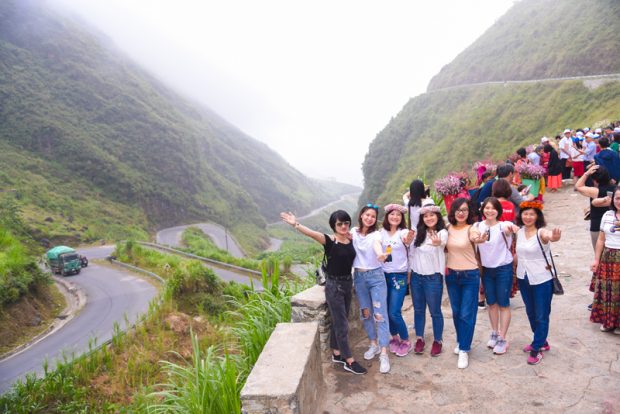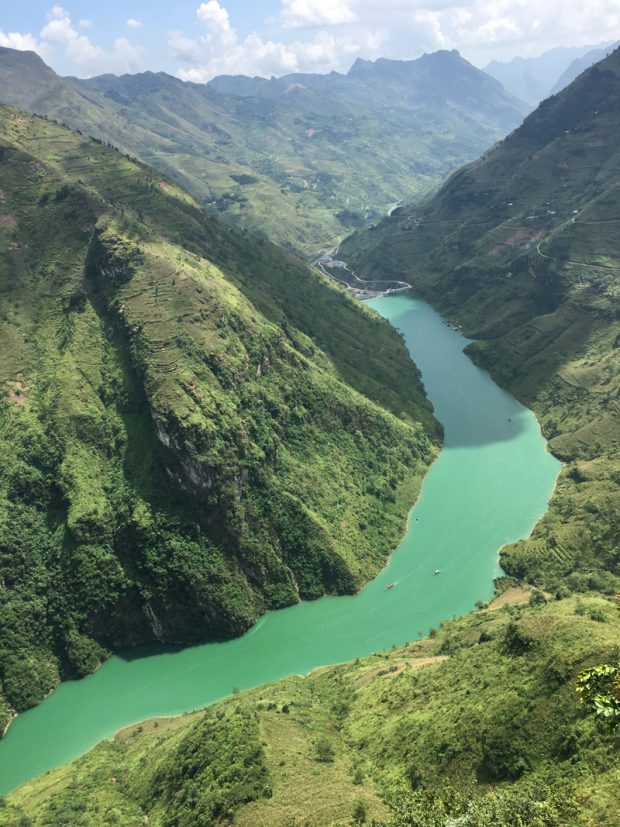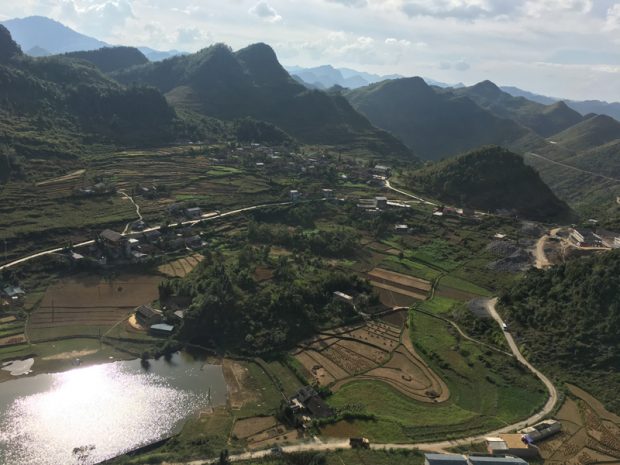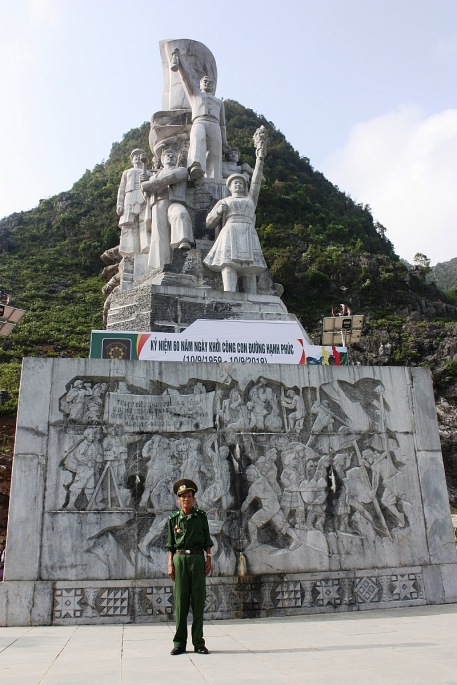Happiness Road: A road of blood and flowers

Tourists pose for a photo at the Tham Ma mountain slope by the Happiness Road in Dong Van District
By Phong Lan
Vietnam
Ha Giang: Spanning 185 kilometres through high mountains and deep valleys, the Happiness Road connects Ha Giang City with two remote mountainous districts of Dong Van and Meo Vac in Vietnam’s northernmost province of Ha Giang.
The road, running through the stunning Dong Van Karst Plateau Global Geopark, is a popular destination among visitors to the country.
Although it is named the Happiness Road, it is also widely called as the “Road of Blood and Flowers” in reference to the hardship of workers and benefits for local people during the construction of the toughest mountain road in the country.
According to a report by Ha Giang Province on the construction of the road, in 1959, after chasing out the French colonists, the newly established Vietnamese Government decided to open a road in this northernmost province where over 60,000 residents were isolated by long distances and difficult terrain.
More than 1,300 young volunteers and over 1,000 workers from 16 different communities living in eight neighbouring provinces were mobilised to build the road.
Most of the section was done by expanding the existing small paths that local residents opened to travel mostly on foot or with horses while some others were generated by the workers themselves. Using their own hands and simple tools such as axes, hammers, and chisels, workers took over six years to dig into the mountains to open the road mostly.
The toughest section linking the two furthermost Dong Van and Meo Vac districts spans 21 kilometres through very high mountains, including the province’s highest peak on Ma Pi Leng Pass. It took nearly two years to complete this section.
To make a two-kilometre way on the Ma Pi Leng Pass alone, the 17 strongest, most skillful and most brave workers were selected to hang themselves to dig into the mountains and place explosives. This was a dangerous task and the team members all knew that they might lose their lives at any time. A tribute ceremony used to be held for them every morning before they were sent out to carry out the deadly task. Unfortunately, 14 of them died while working here.
Despite hard work and poor living condition, the workers, who were mostly in their twenties did their work with all their enthusiasm and willing to sacrifice their life to building the country.

A view of the Nho Que River from Ma Pi Leng Pass
As the province held a ceremony to celebrate the 60th anniversary of the construction of the road in September, Nguyen Manh Thuy, former chairman of the Ha Giang Provincial Young Volunteers Association, who was among the 1,300 young volunteers joining in the road construction, told the Vnexpress Newspaper that despite hardship, it was the most beautiful time in his life.
“Although I was born and raised in Nam Dinh Province which is some 600 kilometres from Ha Giang, many of my friends and I followed the call from the government to build the road,” the 80-year-old man recalled. “We didn’t think much about the hardship. We just thought that we were young and healthy, and the work was suitable for us, so we should take over it to help build our country.”
They remembered having poor meals with just rice and dry fish, sleeping in cold tents built besides the road out of leaves with water shortage and no electricity, and struggling with malaria.
“But we all accepted and found our joy in the changing of local people’s life as the road reached their remote villages,” he added. “We were loved by them.”

The road leads to a village in a valley
In 1961, when president Ho Chi Minh came to visit Ha Giang, hearing local residents share that the road was bringing them a better life, he suggested calling it the Happiness Road. The name of the road is also the wish for happiness that the local people here sent to the future.
He stressed that he could never forget the happy faces of thousands of local residents on the opening day of the road on June 15, 1965 when they saw lines of cars and trucks running on the road through their villages for the first time in their lives.
“After finishing the road construction, many of us decided to stay in Ha Giang. And we are staying until now,” he said.
After the road was completed, a monument was built in Meo Vac District to honour the great sacrifice of the young volunteers and workers for this road.

A war veteran poses at the monument of young volunteers of the Happiness Road project (Photo by Tamnhin)
Since its opening, the Happiness Road has not only helped dozens of ethnic minority groups in this remote area to better access the outside world but also helped visitors easily reach the stunning Dong Van Karst Plateau Global Geopark and learn more about the diverse cultures of local people.
The winding road has become an iconic site of Ha Giang.
How to get there: From Hanoi, the easiest and cheapest way to Ha Giang is to take a passenger bus at My Dinh Bus Station. It takes around eight hours to get to Ha Giang City. Bus ticket costs around VND 300,000 (USD13)/person.
From Ha Giang City, the ideal way to enjoy the breathtaking views of the Dong Van Karst Plateau Global Geopark and surrounding villages is to hire a motorbike and drive on the Happiness Road. Bike rental services are available in Ha Giang City at about VND200,000 (USD8-9) a day.
The best time for Ha Giang is Spring (February-April) and Autumn (August-October).
























































